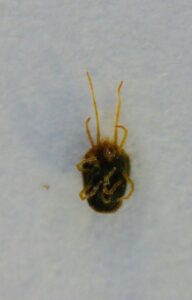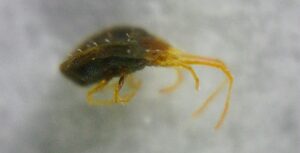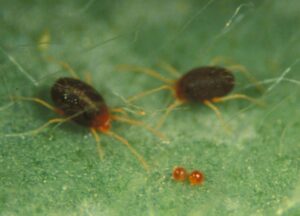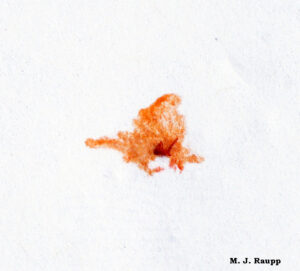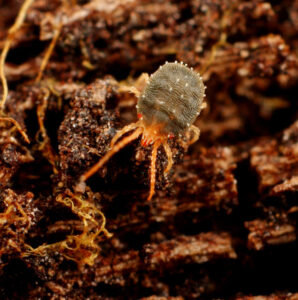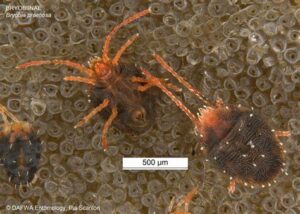I have had a few individuals (homeowners and pest management professionals) reach out to me about infestations of tiny mites that are aggregating on their structures, windowsills, and even seeing them invade indoors! For most of us in Texas, we won’t ever have to battle the army of microscopic mites – known as clover mites, or brown mites. In north Texas, however, this may be a sight we are all too familiar with as the end of winter approaches and temperatures rise. The clover mite, scientifically known as Bryobia praetiosa Koch (Acari: Tetranychidae), is a common pest found all over the world. In North America, they are distributed throughout the United States and southern Canada.
Biology:
Clover mites prefer cooler weather, around 50-80 degrees Fahrenheit, according to most sources I have come across. Therefore, they are most active in the spring and fall seasons. Clover mites are parthenogenetic, meaning they develop from unfertilized eggs, and their population is composed entirely of females. They undergo five developmental life stages: egg, larva, protonymph, deutonymph, and adult. Eggs are bright red in color and laid in various protected areas in the environment. Six-legged larvae hatch from these eggs and are also a bright red color. the next two nymphal stages (protonymph and deutonymph) are eight -legged, like the adults but the legs appear more or less equal in size. By the time the adult emerges, they are a light to dark reddish or greenish brown color, and easily identifiable by their first pair of legs being nearly twice the length of the rest and extending forward past the head. A generation lasts approximately one month, and adult clover mites live for about two weeks outdoors, as long as weather conditions are suitable for their development. Females can lay up to 70 eggs during their lifespan.
Habitat and Plant Preference:
Clover mites primarily live in lawns and feed on grasses and herbaceous plants. They seem to be a fairly generalist feeder, being found on over 200 different plant species, but have a preference for clovers and grasses. They can also feed on certain ornamental shrubs and trees. They are more likely to be found on heavily fertilized lawns and prefer plants in nutrient-rich soil. They overwinter in any dry – protected location, mostly in the egg stage. The overwintering eggs appear in the cracks and crevices of concrete sidewalks, under the bark of trees, and between the walls of buildings. When these eggs hatch in the spring, there are multiple generations during the period of favorable weather. However, as the temperature increases beyond ~85 degrees Fahrenheit, the clover mite will enter a dormancy period of inactivity and will continue reproduction and development in the fall when temperatures cool down again.
Pest Status:
Clover mites are considered nuisance pests. They do not cause damage to food or structures and do not carry diseases that can harm people or plants. However, they can become a problem when they invade homes in large numbers. Because these mites are parthenogenetic, they do not need to mate for reproduction to occur. Once the female mite matures, she can begin laying eggs. They do not reproduce under indoor conditions and will perish shortly after coming inside. Some homeowners attempt to wipe these mites up as a means to remove them. This will result in a smear or stain (see photo below) that will make a mess of fabrics and walls. You should, instead, use a handheld vacuum to remove mites indoors and dispose of the contents immediately.
IPM Control Tactics:
Integrated Pest Management (IPM) is a sustainable approach to managing pests by combining biological, cultural, physical, and chemical tools in a way that minimizes economic, health, and environmental risks. Here are some IPM recommendations for clover mites:
- Create a turf- and weed-free boundary around buildings: A 3-5 feet wide minimum boundary can help deter mites.
- Use pea-gravel or mulch within the boundary.
- Plant unattractive plants within the boundary: Plants such as geranium, chrysanthemum, zinnia, marigold, salvia, rose, petunia, or shrubs such as barberry, juniper, and yew are unattractive to clover mites.
- Ensure that seals around windows are in good repair: This can prevent mites from entering the home.
- Use plant protection products: These can help protect plants from mite infestation.
- Mite numbers can be reduced using high pressure water spray from a hose or through use of pesticides. Use only insecticides and/or miticides with label directions for controlling mites.
- For host plants around the structure, insecticidal soaps, horticultural oils, or products containing other ingredients including pyrethroid insecticides (e.g., bifenthrin) may be suitable. Spot treatments of contact insecticides can be applied to foundation walls and other areas where mites are aggregating. Particular attention should be paid to the junction between the building foundation and landscape soil.
- However, use of insecticide may be unnecessary by addressing the source of the mites in the landscape by mowing, weeding or use of high-pressure water sprays.
In conclusion, while clover mites can be a nuisance, they can be effectively managed using a combination of the above strategies. Homeowners should consider these tactics when treating their property for clover mites.
